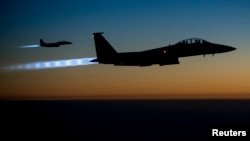The commander in charge of U.S. air operations in the Middle East says the United States and Russia have communicated more via an established military hotline as the airspace around Islamic State territory in Syria has become more crowded.
"We have had to increase the amount of deconfliction work we are doing with the Russians, given the tighter airspace that we are now working ourselves through," Air Force Lieutenant General Jeffrey Harrigian told reporters Wednesday.
Islamic State has been reduced from its peak of about 30,000 fighters in Iraq and Syria to current estimates of fewer than 15,000.
The communication hotline was created between Russia and the U.S. several months ago to avoid misunderstandings or unintended incidents in the sky over Syria.
Harrigian confirmed the U.S. has established deconfliction zones around U.S. military personnel inside Syria, adding that Russian movement within these areas is restricted to protect American and U.S.-backed forces.
"There have been times we've had to work through mitigation strategies to ensure we can continue our mission, and vice versa," he said. "The Russians are understanding of what we're trying to do."
Harrigian added that communication on the hotline is not always easy, however, and sometimes it takes multiple calls to work through one deconfliction issue.
A recent example of this communication came last week when the U.S. conducted what Defense Secretary Jim Mattis called a "self-defense" strike against Iranian-directed, pro-Syrian government forces.
The forces violated a coalition deconfliction zone that had been established within a 55-kilometer radius of the al-Tanf army base, where U.S.-led coalition forces are training Syrian militias fighting IS.
U.S. officials said that, as the pro-Syrian government forces began creating fighting positions near the base, they used the deconfliction hotline to see whether the Russians could get the pro-Syrian forces to leave the area.
When that failed, the coalition launched airstrikes against the forces, destroying a tank, two front-end loaders, another piece of construction equipment and a tactical vehicle, according to a U.S. Central Command strike release.







